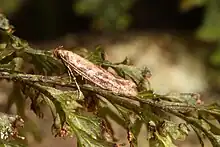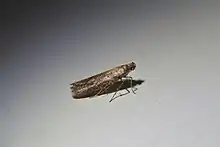| Cadmogenes | |
|---|---|
 | |
| Scientific classification | |
| Kingdom: | |
| Phylum: | |
| Class: | |
| Order: | |
| Family: | Plutellidae (disputed) |
| Genus: | Cadmogenes Meyrick, 1923 |
| Species: | C. literata |
| Binomial name | |
| Cadmogenes literata | |
Cadmogenes is a genus of moths of the family Plutellidae. It contains only one species, Cadmogenes literata, which is found in New Zealand. This species is endemic to New Zealand. It has been classified as "Not Threatened" by the Department of Conservation.
Taxonomy
The genus Cadmogenes was described in the family Plutellidae, but is considered an enigmatic unplaced genus (along with the genus Titanomis) and may require its own family.[2][3][4]
Cadmogenes literata was first described by Edward Meyrick in 1923 using specimens collected at Silverstream and Auckland in January.[5] George Hudson described and illustrated this species in his 1928 book The Butterflies and Moths of New Zealand.[6] The lectotype specimen was collected at Kauri Gully, Birkenhead, Auckland by George Hudson and is held at the Natural History Museum, London.[7]
Description
.jpg.webp)

Meyrick described the species as follows:
♂︎. 15-17 mm. Head and thorax dull rosy or purple-fuscous. Palpi rosy irrorated with dark fuscous, tip whitish. Abdomen light-greyish. Forewings elongate, costa gently arched, apex obtuse-pointed, very slightly prominent, termen rounded, rather strongly oblique ; dull crimson suffusedly speckled with dark grey and irregularly marbled and strigulated with pale ochreous-yellowish, or purple-fuscous obscurely dotted and strigulated with whitish ; discal stigmata represented by irregular transverse-linear sometimes interrupted white partially dark-edged marks : cilia light rosy or violet-grey. Hindwings pale grey ; cilia whitish-grey, with very faint rosy or purple tinge.[5]
The wing venation of the adult moth differs depending on whether the larvae is reared from Pterophylla or Caldcluvia inflorescences.[7]
Distribution
This species is endemic to New Zealand.[1][8] C. literata occurs in the Northland, Auckland, Taupo, Taranaki and Wellington areas.[7][9]
Host species and biology
The larvae feed on the flowers of Caldcluvia and Weinmannia species.[9] There is one generation per year.[7] The type locality of Kauri Gully now has few Weinmannia trees but these are abundant at Silverstream.[7]
Conservation status
This species has been classified as having the "Not Threatened" conservation status under the New Zealand Threat Classification System.[10]
References
- 1 2 "Cadmogenes literata Meyrick, 1923". www.nzor.org.nz. Landcare Research New Zealand Ltd. Retrieved 2018-05-27.
- ↑ Krell, Frank-Thorsten; Bettman, David; Gilligan, Todd, eds. (2012). "Program and Proceedings of the International Lepidopterists' Conference, Denver, July 23–29, 2012" (PDF). www.dmns.org. Archived from the original (PDF) on 22 March 2016. Retrieved 16 May 2018.
- ↑ Heikkilä, Maria; Mutanen, Marko; Wahlberg, Niklas; Sihvonen, Pasi; Kaila, Lauri (21 November 2015). "Elusive ditrysian phylogeny: an account of combining systematized morphology with molecular data (Lepidoptera)". BMC Evolutionary Biology. 15 (1): 260. doi:10.1186/s12862-015-0520-0. PMC 4654798. PMID 26589618.
- ↑ Hoare, R.J.B. (2012). "Marvels, mysteries and challenges in the New Zealand Lepidoptera fauna" (PDF). Program and Proceedings of the International Lepidopterists' Conference, Denver, July 23–29, 2012. International Lepidopterists' Conference, Denver, July 23–29, 2012. Denver Museum of Natural History. p. 20. OCLC 827976504. Archived from the original (PDF) on 22 March 2016. Retrieved 24 January 2018.
- 1 2 Meyrick, Edward (1923). "Descriptions of New Zealand Lepidoptera". Transactions and Proceedings of the New Zealand Institute. 54: 162–169 – via Biodiversity Heritage Library.
- ↑ Hudson, G. V. (1928). The Butterflies and Moths of New Zealand. Wellington: Ferguson & Osborn Ltd. pp. 327–328.
- 1 2 3 4 5 Dugdale, John S. (1988). "Lepidoptera - annotated catalogue, and keys to family-group taxa" (PDF). Fauna of New Zealand. 14: 1–269. Archived from the original (PDF) on 2019-01-27. Retrieved 2018-05-27 – via Landcare Research New Zealand Ltd.
- ↑ Gordon, Dennis P., ed. (2010). New Zealand inventory of biodiversity: Kingdom animalia : chaetognatha, ecdysozoa, ichnofossils. Vol. 2. p. 465. ISBN 978-1-877257-93-3. OCLC 973607714. OL 25288394M. Wikidata Q45922947.
- 1 2 Patrick, Brian; Dugdale, John S. (2000). Conservation status of the New Zealand lepidoptera (PDF). Wellington, N.Z.: Department of Conservation, New Zealand. ISBN 0478218672. OCLC 154670803.
- ↑ Hoare, R.J.B.; Dugdale, J.S.; Edwards, E.D.; Gibbs, G.W.; Patrick, B.H.; Hitchmough, R.A.; Rolfe, J.R. (2017). "Conservation status of New Zealand butterflies and moths (Lepidoptera), 2015" (PDF). New Zealand Threat Classification Series. 20: 9.